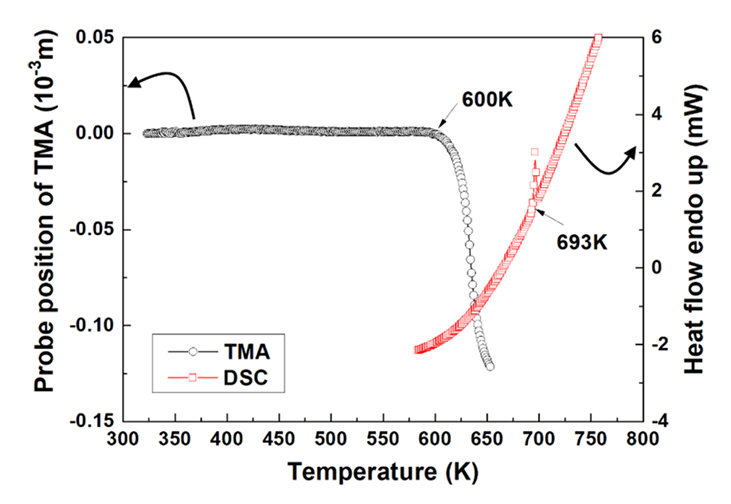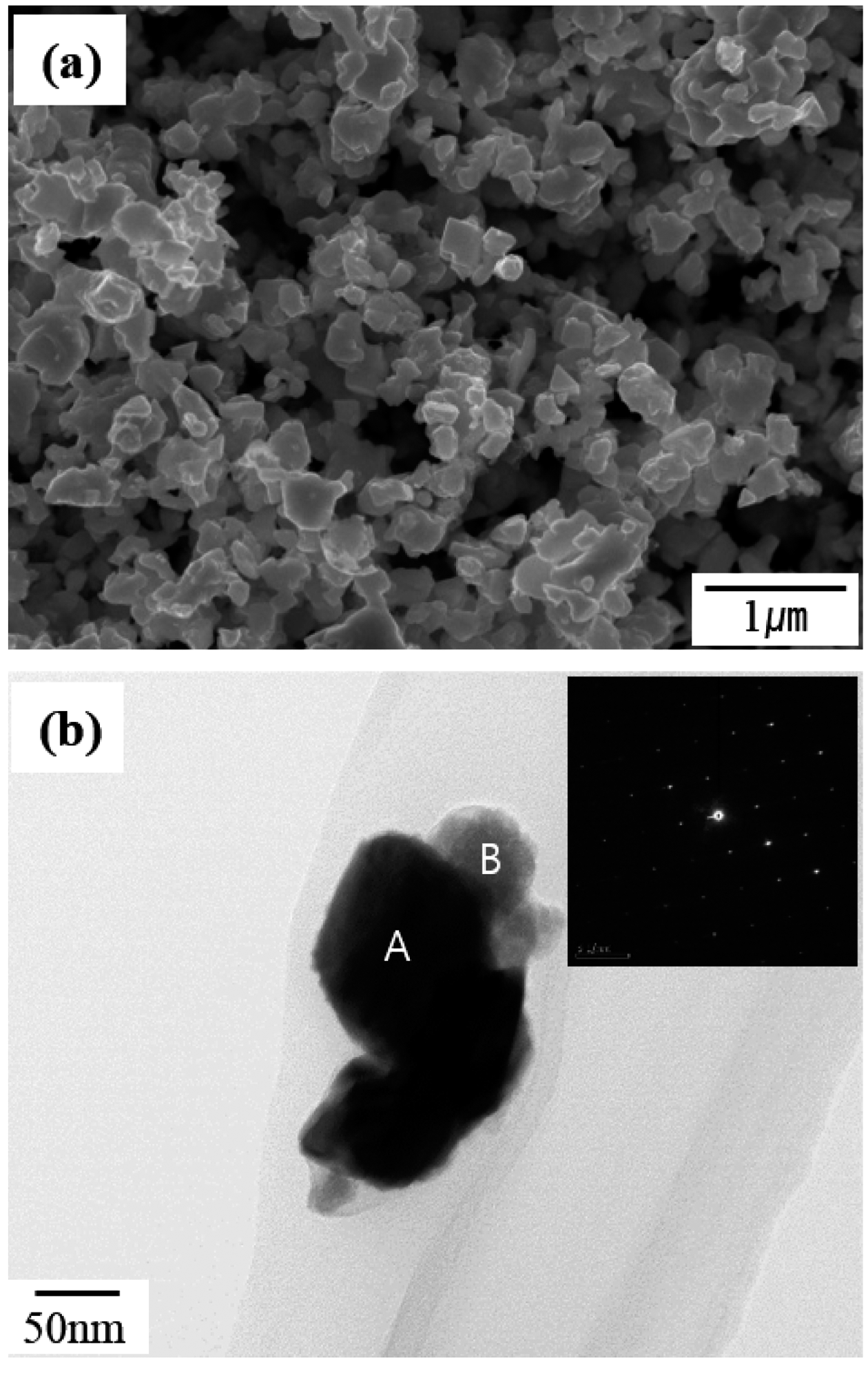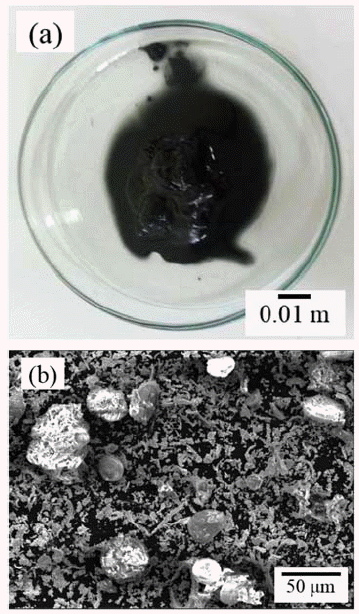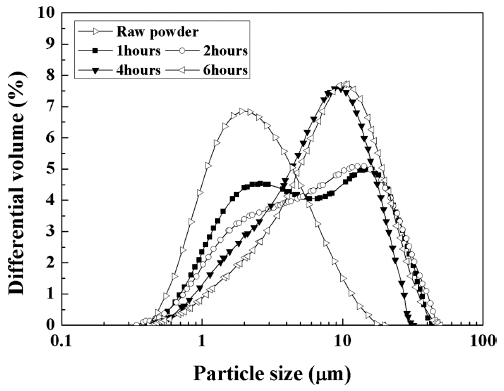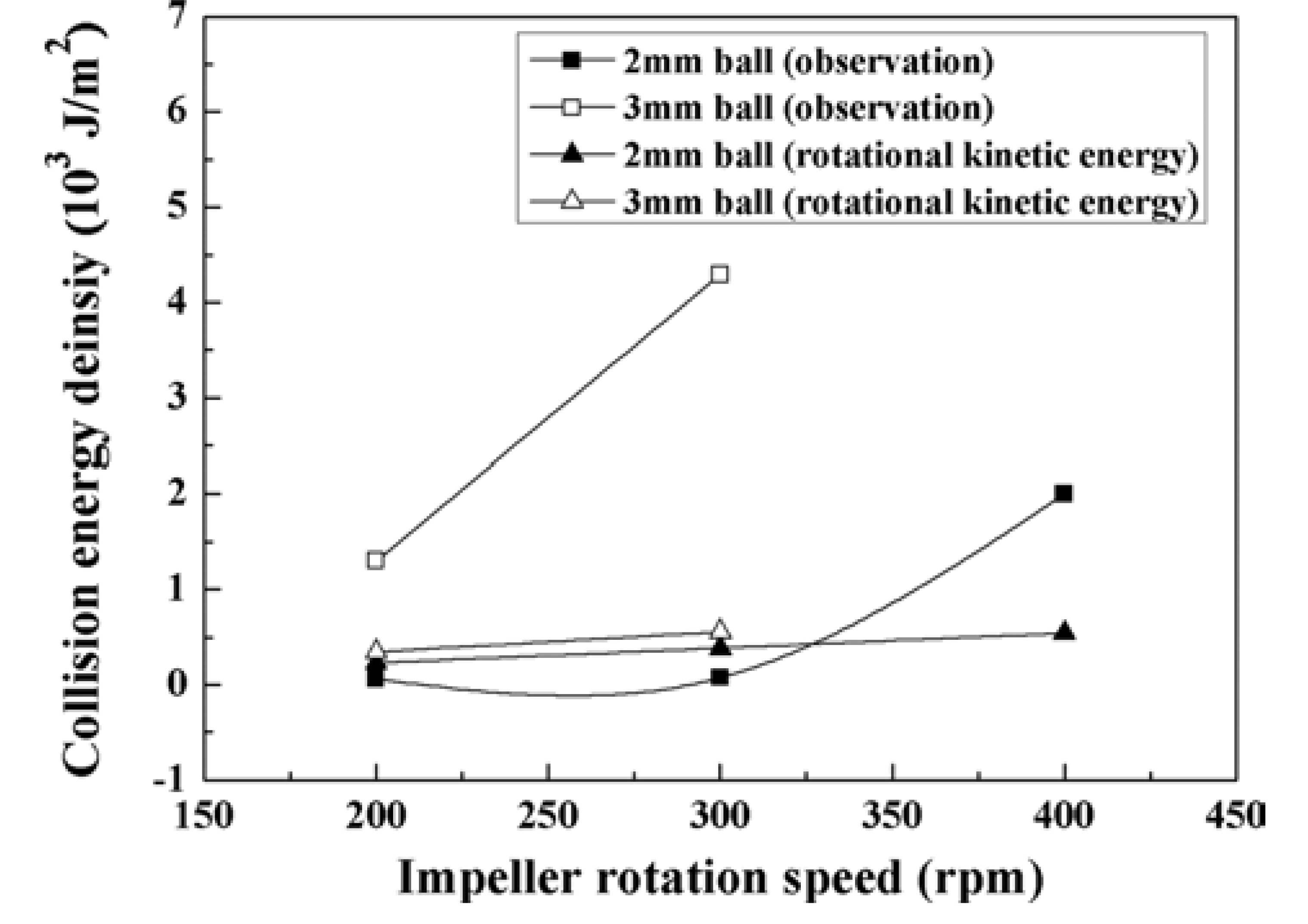- [Korean]
- Fabrication of WC/Co composite powder from oxide of WC/Co hardmetal scrap by carbothermal reduction process
-
Gil-Geun Lee, Young Soo Lim
-
J Korean Powder Metall Inst. 2018;25(3):240-245. Published online June 1, 2018
-
DOI: https://doi.org/10.4150/KPMI.2018.25.3.240
-
-
 Abstract Abstract
 PDF PDF
This study focuses on the fabrication of a WC/Co composite powder from the oxide of WC/Co hardmetal scrap using solid carbon in a hydrogen gas atmosphere for the recycling of WC/Co hardmetal. Mixed powders are manufactured by mechanically milling the oxide powder of WC-13 wt% Co hardmetal scrap and carbon black with varying powder/ball weight ratios. The oxide powder of WC-13 wt% Co hardmetal scrap consists of WO3 and CoWO4. The mixed powder mechanically milled at a lower powder/ball weight ratio (high mechanical milling energy) has a more rapid carbothermal reduction reaction in the formation of WC and Co phases compared with that mechanically milled at a higher powder/ball weight ratio (lower mechanical milling energy). The WC/Co composite powder is fabricated at 900°C for 6 h from the oxide of WC/Co hardmetal scrap using solid carbon in a hydrogen gas atmosphere. The fabricated WC/Co composite powder has a particle size of approximately 0.25-0.5 μm.
- [Korean]
- Recovery of Tungsten from WC/Co Hardmetal Sludge by Alkaline Leaching Hydrometallurgy Process
-
Gil-Geun Lee, Ji-Eun Kwon
-
J Korean Powder Metall Inst. 2016;23(5):372-378. Published online October 1, 2016
-
DOI: https://doi.org/10.4150/KPMI.2016.23.5.372
-
-
453
View
-
3
Download
-
1
Citations
-
 Abstract Abstract
 PDF PDF
This study focuses on the development of an alkaline leaching hydrometallurgy process for the recovery of tungsten from WC/Co hardmetal sludge, and an examination of the effect of the process parameters on tungsten recovery. The alkaline leaching hydrometallurgy process has four stages, i.e., oxidation of the sludge, leaching of tungsten by NaOH, refinement of the leaching solution, and precipitation of tungsten. The WC/Co hardmetal sludge oxide consists of WO3 and CoWO4. The leaching of tungsten is most affected by the leaching temperature, followed by the NaOH concentration and the leaching time. About 99% of tungsten in the WC/Co hardmetal sludge is leached at temperatures above 90°C and a NaOH concentration above 15%. For refinement of the leaching solution, pH control of the solution using HCl is more effective than the addition of Na2S·9H2O. The tungsten is precipitated as high-purity H2WO4·H2O by pH control using HCl. With decreasing pH of the solution, the tungsten recovery rate increases and then decrease. About 93% of tungsten in the WC/Co hardmetal sludge is recovered by the alkaline leaching hydrometallurgy process. -
Citations
Citations to this article as recorded by  - Fabrication of tungsten oxide powder from WC–Co cemented carbide scraps by oxidation behaviour
Min Soo Park, Jong-Min Gwak, Kyeong-mi Jang, Gook-Hyun Ha
Powder Metallurgy.2023; 66(5): 688. CrossRef
- [Korean]
- Fabrication of Silver Flake Powder by the Mechanical Milling Process
-
Hae-Young Jeong, Gil-Geun Lee
-
J Korean Powder Metall Inst. 2016;23(1):54-60. Published online February 1, 2016
-
DOI: https://doi.org/10.4150/KPMI.2016.23.1.54
-
-
328
View
-
2
Download
-
1
Citations
-
 Abstract Abstract
 PDF PDF
This study focuses on fabricating silver flake powder by a mechanical milling process and investigating the formation of flake-shaped particles during milling. The silver flake powder is fabricated by varying the mechanical milling parameters such as the amount of powder, ball size, impeller rotation speed, and milling time of the attrition ballmill. The particle size of the silver flake powder decreases with increasing amount of powder; however, it increases with increasing impeller rotation speed. The change in the particle size of the silver flake powder is analyzed based on elastic collision between the balls, taking energy loss of the balls due to the powder into consideration. The change in the particle size of the silver flake powder with mechanical milling parameters is consistent with the change in the diameter of the elastic deformation contact area of the ball, due to the collision between the balls, with milling parameters. The flake-shaped silver particles are formed at the elastic deformation contact area of the ball due to the collision. -
Citations
Citations to this article as recorded by  - Fabrication of WC/Co composite powder from oxide of WC/Co hardmetal scrap by carbothermal reduction process
Gil-Geun Lee, Young Soo Lim
journal of Korean Powder Metallurgy Institute.2018; 25(3): 240. CrossRef
- [Korean]
- Effect of Mechanical Milling Parameters on the Particle Size of Silver Flake
-
Gil-Geun Lee, Hae-Young Jeong
-
J Korean Powder Metall Inst. 2014;21(4):307-312. Published online August 1, 2014
-
DOI: https://doi.org/10.4150/KPMI.2014.21.4.307
-
-
393
View
-
1
Download
-
1
Citations
-
 Abstract Abstract
 PDF PDF
This study is focused on investigating the relation between the particle size of silver flake powder and mechanical milling parameters. Mechanical milling parameters such as ball size, impeller rotation speed and milling time of the attrition ball-mill were controlled to produce silver flake powder. The particle size of the silver flake powder increased with increasing ball size and impeller rotation speed. The change of the particle size of the silver flake powder with mechanical milling parameters was analyzed based on balls motion in the mill container of the attrition ballmill. The silver flake particles were formed at the elastic deformation area of the ball due to the collision between balls. The change of the particle size of the silver flake powder with mechanical milling parameters well consists with the change of the collision energy of ball with parameters mentioned above. -
Citations
Citations to this article as recorded by  - Fabrication of Silver Flake Powder by the Mechanical Milling Process
Hae-Young Jeong, Gil-Geun Lee
Journal of Korean Powder Metallurgy Institute.2016; 23(1): 54. CrossRef
- [Korean]
- Carbothermal Reduction of Oxide Powder Prepared from Waste WC/Co Hardmetal by Solid Carbon
-
Gil-Geun Lee, Gook-Hyun Ha
-
J Korean Powder Metall Inst. 2005;12(2):112-116.
-
DOI: https://doi.org/10.4150/KPMI.2005.12.2.112
-
-
421
View
-
1
Download
-
4
Citations
-
 Abstract Abstract
 PDF PDF
- In the present study, the focus is on the analysis of carbothermal reduction of oxide powder prepared from waste WC/Co hardmetal by solid carbon under a stream of argon for the recycling of the WC/Co hard-metal. The oxide powder was prepared by the combination of the oxidation and crushing processes using the waste WC-8 wt.%Co hardmetal as the raw material. This oxide powder was mixed with carbon black, and then this mixture was carbothermally reduced under a flowing argon atmosphere. The changes in the phase structure and gases discharge of the mixture during carbothermal reduction was analysed using XRD and gas analyzer. The oxide powder prepared from waste WC-8wt.%Co hardmetal has a mixture of WO_3 and CoWO_4. This oxide powder reduced at about 850°C, formed tungsten carbides at about 950°C, and then fully transformed to a mixed state of tungsten carbide (WC) and cobalt at about 1100°C by solid carbon under a stream of argon. The WC/Co composite powder synthesized at 1000°C for 6 hours from oxide powder of waste WC-8wt.%Co hardmetal has an average particle size of 0.3 µm.
-
Citations
Citations to this article as recorded by  - Effects of mechanical milling on the carbothermal reduction of oxide of WC/Co hardmetal scrap
Gil-Geun Lee, Gook-Hyun Ha
Metals and Materials International.2016; 22(2): 260. CrossRef - Recovery of Tungsten from WC/Co Hardmetal Sludge by Alkaline Leaching Hydrometallurgy Process
Gil-Geun Lee, Ji-Eun Kwon
Journal of Korean Powder Metallurgy Institute.2016; 23(5): 372. CrossRef - Recovery of tungsten carbide from hard material sludge by oxidation and carbothermal reduction process
Woo-Gwang Jung
Journal of Industrial and Engineering Chemistry.2014; 20(4): 2384. CrossRef - Trend on the Recycling Technologies for the used Tungsten Carbide(WC) by the Patent and Paper Analysis
Jin-Ki Jeong, Jae-Chun Lee, Sang-Woo Park, Kyung-Seok Kang
Journal of the Korean Institute of Resources Recycling.2012; 21(1): 82. CrossRef
- [Korean]
- Effect of Mold Dimensions on Temperature Distribution of Die during Plasma Activated Sintering
-
Gil-Geun Lee, IK-Min Park
-
J Korean Powder Metall Inst. 2004;11(5):363-368.
-
DOI: https://doi.org/10.4150/KPMI.2004.11.5.363
-
-
 Abstract Abstract
 PDF PDF
- In the present study, the focus is on the analysis of the effect of the mold dimensions on the temperature distribution of a die during plasma activated sintering. The temperature distribution of a cylindrical mold with various dimensions was measured using K-type thermocouples. The temperature homogeneity of the die was studied based on the direction and dimensions of the die. A temperature gradient existed in the radial direction of the die during the plasma activated sintering. Also, the magnitude of the temperature gradient was increased with increasing sintering temperature. In the longitudinal direction, however, there was no temperature gradient. The temperature gradient of the die in the radial direction strongly depended on a ratio of die volume to punch area.
|
